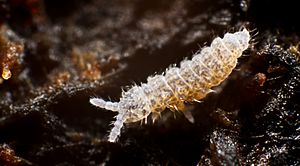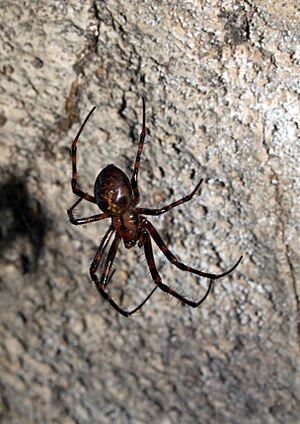Radford Cave facts for kids
Radford Cave, located in Hexton Wood near Hooe, Plymouth, Devon, is a small cave that's interesting for its unique environment and the animals living there. People have known about this cave for many years.
Exploring Radford Cave
Radford Cave is a popular spot for people who love adventure and those who are new to caving. It's easy to explore because you can go in and out without getting lost. However, sometimes people who are not careful or are too excited can get stuck. For example, a long time ago, a caving instructor got stuck and needed help to get free.
To protect the bats that live inside, the cave is kept locked. This helps keep their home safe and undisturbed.
Inside the Cave
The cave is found in an old quarry made of Devonian limestone rock. All the passages inside the cave add up to about 600 meters (almost 2,000 feet) in length. The temperature inside the cave stays pretty steady, around 12-13 degrees Celsius (about 54 degrees Fahrenheit). Air usually moves into the cave during the day and out at night.
The tallest parts of the cave can be about 9 meters (nearly 30 feet) high. The air inside is very humid, usually between 93% and 98%. The water pools in the cave have a pH of 7.7, which is slightly alkaline. There isn't much organic matter in the cave's clay, so it's not a great food source for tiny creatures.
Cave Animals
Many scientists who study cave animals have explored Radford Cave. Both the Greater Horseshoe Bat and the Lesser Horseshoe Bat have been seen living here. These bats are very important to the cave's ecosystem.
Tiny creatures called invertebrates have also been studied in the cave. Records of these animals are kept by the British Cave Research Association. You can find small creatures like the isopod Androniscus dentiger and the mite Eugamasus loricatus deep inside the cave where it's always dark.
The most common springtails (tiny, jumping insects) are Heteromurus nitidus, which are lightly colored. Another type, the white Pseudosinella dobati, also lives in the cave. Both of these springtails are about 1.7 millimeters long. Other springtails found include Entomobrya muscorum, Schaefferia emucronata (shown here), S. lindbergi, Onychiurus armatus, Neelus murinus, Arrhopalites caecus, and A. pymaegus. Springtails are especially common in a part of the cave called the Red Corridor, where the air is very humid.
The spider Meta menardii (also shown here) lives near the entrance of the cave and sometimes ventures into the darker areas.



